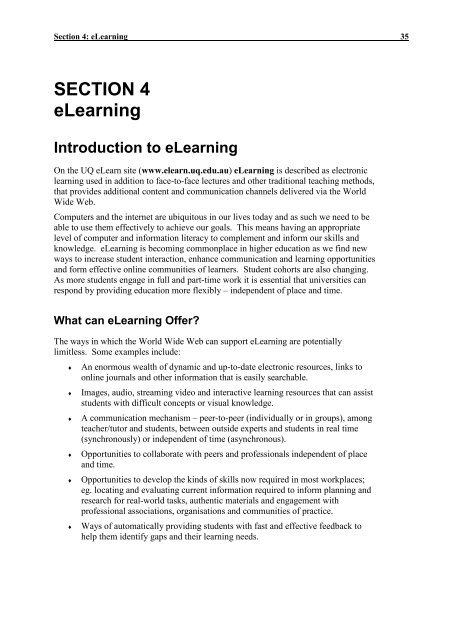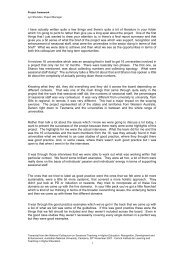A tutor's guide to teaching and learning at UQ - TEDI - University of ...
A tutor's guide to teaching and learning at UQ - TEDI - University of ...
A tutor's guide to teaching and learning at UQ - TEDI - University of ...
You also want an ePaper? Increase the reach of your titles
YUMPU automatically turns print PDFs into web optimized ePapers that Google loves.
Section 4: eLearning 35SECTION 4eLearningIntroduction <strong>to</strong> eLearningOn the <strong>UQ</strong> eLearn site (www.elearn.uq.edu.au) eLearning is described as electronic<strong>learning</strong> used in addition <strong>to</strong> face-<strong>to</strong>-face lectures <strong>and</strong> other traditional <strong>teaching</strong> methods,th<strong>at</strong> provides additional content <strong>and</strong> communic<strong>at</strong>ion channels delivered via the WorldWide Web.Computers <strong>and</strong> the internet are ubiqui<strong>to</strong>us in our lives <strong>to</strong>day <strong>and</strong> as such we need <strong>to</strong> beable <strong>to</strong> use them effectively <strong>to</strong> achieve our goals. This means having an appropri<strong>at</strong>elevel <strong>of</strong> computer <strong>and</strong> inform<strong>at</strong>ion literacy <strong>to</strong> complement <strong>and</strong> inform our skills <strong>and</strong>knowledge. eLearning is becoming commonplace in higher educ<strong>at</strong>ion as we find newways <strong>to</strong> increase student interaction, enhance communic<strong>at</strong>ion <strong>and</strong> <strong>learning</strong> opportunities<strong>and</strong> form effective online communities <strong>of</strong> learners. Student cohorts are also changing.As more students engage in full <strong>and</strong> part-time work it is essential th<strong>at</strong> universities canrespond by providing educ<strong>at</strong>ion more flexibly – independent <strong>of</strong> place <strong>and</strong> time.Wh<strong>at</strong> can eLearning Offer?The ways in which the World Wide Web can support eLearning are potentiallylimitless. Some examples include:♦♦♦♦♦♦An enormous wealth <strong>of</strong> dynamic <strong>and</strong> up-<strong>to</strong>-d<strong>at</strong>e electronic resources, links <strong>to</strong>online journals <strong>and</strong> other inform<strong>at</strong>ion th<strong>at</strong> is easily searchable.Images, audio, streaming video <strong>and</strong> interactive <strong>learning</strong> resources th<strong>at</strong> can assiststudents with difficult concepts or visual knowledge.A communic<strong>at</strong>ion mechanism – peer-<strong>to</strong>-peer (individually or in groups), amongteacher/tu<strong>to</strong>r <strong>and</strong> students, between outside experts <strong>and</strong> students in real time(synchronously) or independent <strong>of</strong> time (asynchronous).Opportunities <strong>to</strong> collabor<strong>at</strong>e with peers <strong>and</strong> pr<strong>of</strong>essionals independent <strong>of</strong> place<strong>and</strong> time.Opportunities <strong>to</strong> develop the kinds <strong>of</strong> skills now required in most workplaces;eg. loc<strong>at</strong>ing <strong>and</strong> evalu<strong>at</strong>ing current inform<strong>at</strong>ion required <strong>to</strong> inform planning <strong>and</strong>research for real-world tasks, authentic m<strong>at</strong>erials <strong>and</strong> engagement withpr<strong>of</strong>essional associ<strong>at</strong>ions, organis<strong>at</strong>ions <strong>and</strong> communities <strong>of</strong> practice.Ways <strong>of</strong> au<strong>to</strong>m<strong>at</strong>ically providing students with fast <strong>and</strong> effective feedback <strong>to</strong>help them identify gaps <strong>and</strong> their <strong>learning</strong> needs.



